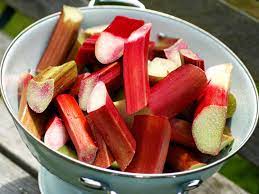Nutritional Value of Rhubarb| Top 8 Health Benefits of Rhubarb.Looking for the nutritional value of rhubarb? Rhubarb is a great source of fiber, vitamin C, and potassium. It also has some unique health benefits, including improved digestion and blood sugar control. Read on to learn more about the top 8 health benefits of rhubarb.
Introduction:
Table of Contents
It is possible to use rhubarb as a vegetable when it is young. When it has reached maturity, it may also be used as a fruit.
Approximately three feet is the maximum height of rhubarb. The stalks of the leaves are pink in color.
Several nutrients are contained in it, such as potassium, phosphorus, calcium, magnesium, sodium, and iron. A, B, C, and E are also present in it.
What is Rhubarb?
Rhubarb is a plant that is grown for its thick, fleshy, edible roots. The roots are typically red or green, and the plant is related to the buckwheat plant.
Rhubarb is often used in pies and other desserts and is also used to make jams and other preserves. The leaves of the rhubarb plant are poisonous, and should not be eaten.
Nutritional value of Rhubarb
A nutritional powerhouse, rhubarb is packed with nutrients! The unusual vegetable contains several essential nutrients, including Vitamin C, potassium, and fiber.
Approximately 20% of the recommended daily value for Vitamin C can be obtained from just one cup of raw rhubarb.
Besides being a good source of calcium, magnesium, and phosphorus, rhubarb is also a good source of fiber.
There are several ways in which this nutrient-rich vegetable can be enjoyed. Pies, cobblers, and other desserts can be prepared with fresh or frozen rhubarb.
For a unique flavor twist, you may wish to add it to smoothies, yogurt, or oatmeal. Rhubarb is a healthy and delicious addition to any diet, whether raw or cooked.
Top 8 Health Benefits of Rhubarb
A delicious, tart-tasting vegetable, rhubarb is commonly used in pies and desserts. However, did you know that rhubarb provides a variety of health benefits as well?
This unique vegetable should be included in your diet for the following reasons:
- It is a good source of fiber, which may help to regulate digestion and promote regularity.
- Several chronic diseases can be reduced by consuming rhubarb, which is high in antioxidants.
- The consumption of rhubarb can reduce cholesterol levels and improve heart health.
- The rhubarb plant is an excellent source of vitamins A and C, which are essential for maintaining skin and immunity.
- Calcium is an important component of the bones, and rhubarb is an excellent source of this nutrient.
- There is evidence that rhubarb may help lower blood sugar levels.
- There is evidence that rhubarb may have anticancer properties.
- Due to its low calorie and fat content, rhubarb is a healthy addition to any diet.
How rhubarb can help you improve your health?
There has been a long history of using rhubarb as a medicine for centuries. Medicine is made from the root and leaves of the plant. Several digestive disorders can be treated with rhubarb, including diarrhea, constipation, stomach pain, and heartburn.
Besides being used for cancer, obesity, and high cholesterol, it is also used for other conditions. Laxatives are used by some people, while others use them to increase appetites or treat anemia.
Among its nutritional benefits, rhubarb contains a high amount of fiber, vitamins, and minerals. Several antioxidants are also present in this food, which may contribute to the protection of cells.
When taken by mouth for a short period, rhubarb is generally considered safe by most individuals. Nevertheless, it may cause side effects such as stomach upset, diarrhea, and vomiting.
Rhubarb is used in a variety of ways
Rhubarb can be used in several different ways
- Rhubarb is used for a wide variety of purposes, including culinary, medicinal, and even decorative ones.
- There are a variety of ways to prepare rhubarb in the kitchen, including pies, jams, and other desserts.
- Sauces and stews can also benefit from the addition of this ingredient.
- A variety of ailments, including digestive issues, fevers, and cancer, have been treated with rhubarb medicinally for centuries.
- Fabrics and yarns can also be dyed with rhubarb.
- The large leaves and bright red stalks of rhubarb make it an attractive addition to any garden.
Conclusion:
It is very common throughout Asia to find rhubarb as a tasty vegetable. Traditional remedies include rhubarb in the treatment of ailments ranging from constipation to cancer.
Several health conditions can be treated with it. We hope that you have enjoyed our blog post regarding the health benefits of rhubarb.
If you have discovered any new benefits of rhubarb, please let us know in the comments!











